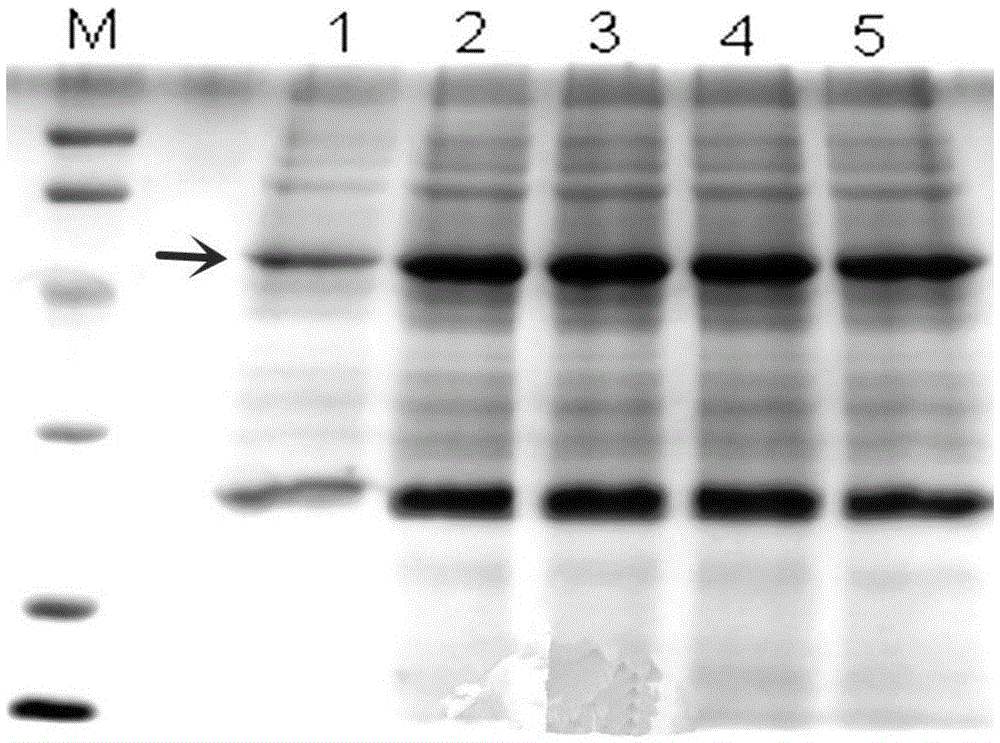Signal peptide capable of effectively improving protein secretion expression efficiency and application of signal peptide
A technology for secretion, expression and signal peptides, applied in the field of signal peptides, can solve problems such as failure to achieve better technical results, and achieve the effect of improving secretion efficiency
- Summary
- Abstract
- Description
- Claims
- Application Information
AI Technical Summary
Problems solved by technology
Method used
Image
Examples
Embodiment 1
[0042] Embodiment 1: a kind of novel signal peptide
[0043] The nucleotide sequence of the signal peptide provided in the present invention is shown in SEQ ID NO: 2, which is obtained by modifying the signal peptides PelB (SEQ ID NO: 4) and OmpA (SEQ ID NO: 5). The N-terminal of the signal peptide uses the first three amino acid residues MKK of the signal peptide OmpA, the middle sequence is the strong hydrophobic sequence LLPTAAAAGLLLLAAQP of PelB, and the C-terminal uses the last three amino acid residues AQA of OmpA. The signal peptide sequence is obtained by chemical synthesis or PCR, and its availability is analyzed by signalP3.0.
[0044] The signal peptide was cloned into the NcoI restriction site of the vector pET-28a(+), and then the target gene PLD was cloned into the C-terminus of the signal peptide, and the secretion of the target protein was effectively enhanced after expression. The secretion of PLD was effectively increased, reaching 0.23g / L, and the extracell...
Embodiment 2
[0045] Example 2: Acquisition of phospholipase D gene.
[0046]The target protein used in the present invention is phospholipase D in Escherichia coli BL21, and its phospholipase D functional gene is obtained by PCR.
[0047] 1. Genome extraction of Escherichia coli BL21.
[0048] 1) Use a 1.5ml Tube to collect 1ml of the bacterial solution, centrifuge at 12,000rpm for 2 minutes, discard the supernatant (cell culture solution).
[0049] 2) Add 180 μl of BufferGL, 20 μl of ProteinaseK (20 mg / ml) and 10 μl of RNaseA (10 mg / ml), shake and mix well, and incubate in a water bath at 56°C for 10 minutes. At this time, the solution should be transparent and clear.
[0050] 3) Add 200 μl of BufferGB and 200 μl of 100% ethanol, and thoroughly mix by pipetting.
[0051] 4) Install the SpinColumn on the CollectionTube, transfer the solution to the SpinColumn, centrifuge at 12,000rpm for 2 minutes, and discard the filtrate.
[0052] 5) Add 500 μl of BufferWA to the SpinColumn, centrifug...
Embodiment 3
[0064] Example 3: Construction of phospholipase D secreted expression strain to induce expression.
[0065] 1. Construction and transformation of recombinant plasmids.
[0066] First, the plasmid pET-28a was linearized with EcoRI and NdeI, purified and recovered. The PCR product and the linearized plasmid were ligated by one-step cloning. The system was as follows: PCR purified product 2ul, linearized pET-28a plasmid 4ul, CEbuffer 4ul, Exnase II 2ul, deionized water 8ul, reacted at 37°C for 30 minutes, and constructed Recombinant plasmid pET-28a-PLD. Then the above plasmid pET-28a-PLD was treated with NcoI endonuclease. Finally, the synthetic signal peptide sequence and linearized pET-28a-PLD were ligated by a one-step cloning method to construct the final plasmid pET-28a-sp-PLD ( Figure 4 ). Send Jin Weizhi for sequencing.
[0067] 2. Induced expression of recombinant bacteria.
[0068] The secreted expression plasmid pET-28a-sp-PLD constructed above was transformed in...
PUM
 Login to View More
Login to View More Abstract
Description
Claims
Application Information
 Login to View More
Login to View More - R&D
- Intellectual Property
- Life Sciences
- Materials
- Tech Scout
- Unparalleled Data Quality
- Higher Quality Content
- 60% Fewer Hallucinations
Browse by: Latest US Patents, China's latest patents, Technical Efficacy Thesaurus, Application Domain, Technology Topic, Popular Technical Reports.
© 2025 PatSnap. All rights reserved.Legal|Privacy policy|Modern Slavery Act Transparency Statement|Sitemap|About US| Contact US: help@patsnap.com



